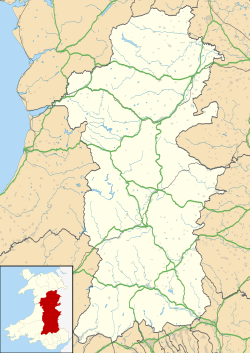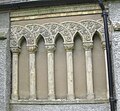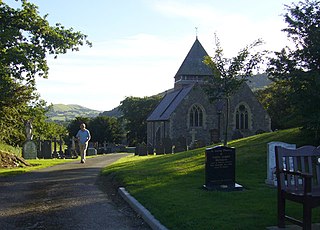
Llandinam is a village and community in Montgomeryshire, Powys, central Wales, between Newtown and Llanidloes, located on the A470. As a community, Llandinam is made up of the village itself, small hamlets including Plas Dinam and Little London and several farms. The village itself has a population of around 576 with 56% born in Wales.

Churchstoke or Church Stoke is a village, community and electoral ward in Montgomeryshire, Powys, Wales. Located in the southeast of the Vale of Montgomery, it is overlooked by Todleth Hill, Roundton Hill and Corndon Hill. The rivers Caebitra and Camlad have their confluence just outside the village. The nearest town is Montgomery. In the 2011 census the village had a population of 708.

Llangedwyn is a village in Montgomeryshire, Powys, Wales. The population of the community at the 2011 census was 402. The community includes the hamlet of Pen-y-bont Llanerch Emrys.

Thomas Penson, or Thomas Penson the younger was the county surveyor of Denbighshire and Montgomeryshire, and an innovative architect and designer of a number of masonry arch bridges over the River Severn and elsewhere.

Llanfechain is a village and community in Powys, Wales, on the B4393 road between Llanfyllin and Llansantffraid-ym-Mechain. Historically it belonged to Montgomeryshire. The River Cain runs through. The population of 465 at the 2011 Census was estimated at 476 in 2019.

Christ Church is a church of the Church in Wales, situated in Rossett, Wrexham County Borough, Wales. It is designated by Cadw as a Grade II listed building. Christ Church is an active Anglican church in the Alyn Mission Area, the archdeaconry of Wrexham and the diocese of St Asaph.

St Garmon's Church is in the centre of the village of Llanarmon-yn-Iâl, Denbighshire, Wales. It is an active Anglican church in the diocese of St Asaph, the archdeaconry of St Asaph and the deanery of Dyffryn Clwyd. It is designated by Cadw as a Grade I listed building.

St Deiniol's Church, Hawarden, is in the village of Hawarden, Flintshire, Wales. It is the parish church of the rectorial benefice of Hawarden in the deanery of Hawarden, the archdeaconry of Wrexham, and the diocese of St Asaph. The church has associations with W. E. Gladstone and his family, and is designated by Cadw as a Grade II* listed building.
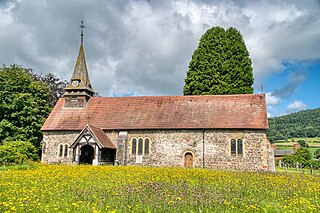
St Garmon's Church, Llanfechain, is in the village of Llanfechain, Powys, Wales. It is an active Anglican parish church in the deanery of Llanfyllin, the archdeaconry of Montgomery, and the diocese of St Asaph, and is designated by Cadw as a Grade II* listed building. The church is traditionally associated with a 9th-century Celtic saint, St Garmon. St Garmon was most likely St Germanus (410–474), the first Bishop of Man. It shares it name with the church in the village of St Harmon in Radnorshire (Powys), where the diarist Francis Kilvert was a curate.

St Michael's Church, Trelawnyd, is in the village of Trelawnyd, Flintshire, Wales. It is an active Anglican parish church in the benefice of Dyserth and Trelawnyd and Cwm, the deanery of St Asaph, the archdeaconry of St Asaph, and the diocese of St Asaph. The church is designated by Cadw as a Grade II* listed building.
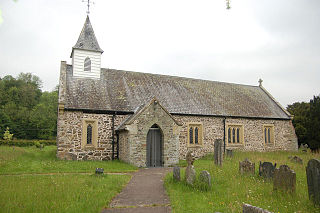
St Michael's Church is in the small village of Manafon, Powys, Wales. It is an active Anglican church in the parish of Llanfair Caereinion, Llanllugan and Manafon, the deanery of Mathrafal, the archdeaconry of Montgomery and the diocese of St Asaph. The church has been designated by Cadw as a Grade II* listed building.
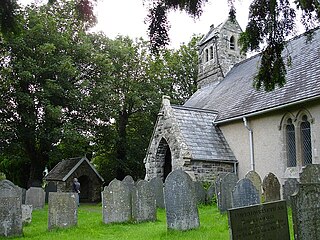
Llangadfan is a small village in Powys, Wales, based in the community of Banwy. The village lies on the A458 between Foel and Llanerfyl, 12 kilometres (7.5 mi) from Llanwddyn. Dyfnant Forest is located nearby. The village is said to be known for its country dances.

St Beuno's Church, Aberffraw is a 12th-century parish church in Anglesey, north Wales. A church was established in Aberffraw in the 7th century by St Beuno, who became the abbot of Clynnog Fawr, Gwynedd. St Beuno's may have been used as a royal chapel during the early Middle Ages, as the princes of Gwynedd had a court in Aberffraw. The oldest parts of the church date from the 12th century, although it was considerably enlarged in the 16th century when a second nave was built alongside the existing structure, with the wall in between replaced by an arcade of four arches. Restoration work in 1840 uncovered a 12th-century arch in the west wall, which may have been the original chancel arch or a doorway to a western tower that has been lost. The church also has a 13th-century font, some memorials from the 18th century, and two 18th-century copper collecting shovels.

St Mary's Church, Llanfair-yng-Nghornwy is a medieval parish church in the north-west of Anglesey, north Wales. The date of foundation of the church, which is in the village of Llanfair-yng-Nghornwy, is unknown, but the oldest parts date from the 11th or 12th century. It has twice been enlarged: in the 15th century, when the chancel was rebuilt, and in the 16th century, when a chapel was added to the south of the chancel, separated by three arches. The tower at the west end is from the 17th century. A south porch of unknown date has been converted into a vestry, and the church is now entered through the tower.
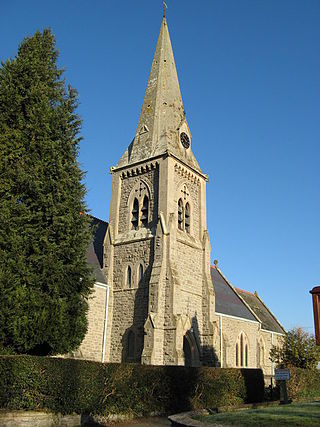
Llandyssil is a village in the community of Abermule with Llandyssil, in Powys, Wales, in the traditional county of Montgomeryshire. It is about two miles from the town of Montgomery.

Christ Church, Welshpool was commissioned by the Earl of Powis to commemorate his son, Edward James, the Viscount Clive, having come of age. It was designed by Thomas Penson and completed 1839–44. The church is characterised by its impressive Romanesque Revival architecture in volcanic Trachyte from the Earl of Powis' Standard quarry in Welshpool. The church consists of a 7-bay nave with offset west tower, aisles, apse and south porch. The west gable of the nave has a wide doorway with triple arches with chevron moulding, while the tower is supported by massive pilaster buttresses. Christ Church was most noted for its interior decoration, and in particular its early use of terracotta. The church was a Chapel of Ease of Welshpool's St Mary's Church and had a separate endowment. It cost £6000 to build and this was raised by public subscription as well as being supported by the Earl. The congregation of Christ Church dropped dramatically during the twentieth century and in 1998 it was closed and sold in 2002 to Karl Meredith and Natalie Bass who are in the process of restoring the church, partly as a house and partly for community use.

St Beuno’s Church is the parish church of Berriew, in the historic county of Montgomeryshire, now Powys. The church stands in an almost oval churchyard in the centre of the village. The original church was a single-chamber, with a wooden west bellcote and a northchancel chapel. This church was replaced in 1803-4 with a larger brick church by the architect John Hiram Haycock of Shrewsbury. It was of brick with stone dressings, and had the entry under a pinnacled west tower to a galleried nave with four round-headed windows a side. The church was largely rebuilt by his grandson, Edward Haycock, Junior in 1876. It consists of a nave, aisles, chancel, north porch, and west tower The west tower has the doorway blocked, stone facing for brick, and Gothic windows, except for the circular ones on its second stage.

St Beuno's Church, Bettws Cedewain lies within the historic county of Montgomeryshire in Powys. The church occupies a prominent position overlooking the village of Bettws Cedewain, on the northern edge of the valley of the Bechan Brook which flows into the River Severn. Bettws is about 9 miles to the south-west of Welshpool. The church is a single-chambered structure with a western tower, set in a near-circular churchyard. A campanile or bellcote was added to the earlier tower in the early 16th century by the vicar, John ap Meredyth, whose memorial brass remains in the church to-day. The church was extensively rebuilt in 1868 under the supervision of the architect William Eden Nesfield. This included a complete rebuild of the upper part of the tower

St Michael's Church is the parish church of Kerry, in the historic county of Montgomeryshire, now Powys. Kerry is sited about 3 miles to the S E of Newtown. which suggests that there may have been a church on the site since the 7th century. The church stands in an almost oval churchyard in the centre of the village. It was rebuilt and re-dedicated in 1176. Of the original church only the north aisle arcade survives, and the chancel arcade is 14th-century in date. The square stone tower is surmounted by a Montgomeryshire style timber-framed belfry. The main body of the church was rebuilt in 1882–83 by the architect George Edmund Street, paid for by James Walton of Dolforgan Hall.

Romanesque Revival, Norman Revival or Neo-Norman styles of building in the United Kingdom were inspired by the Romanesque architecture of the 11th and 12th centuries AD.

